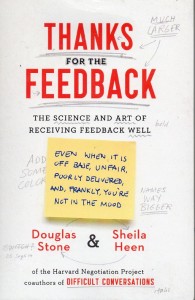Book Review: Thanks for the Feedback by Douglas Stone & Sheila Heen
Disclaimer: I received this book as a Goodreads giveaway on the premise that I would review it. Also, the version I read was an Advance Readers’ Copy and some changes may be made in the final version.
We’ve all been there. You go above and beyond busting your butt on the job for a year, but your boss’ evaluation says “meets minimum standards” and no pay raise. Your mother asks for the thousandth time why you can’t be more like your Nobel Prize winning sister who married a brain surgeon and has provided Mom with two lovely grandchildren. A random crack from a passerby about your nose puts you in a depressed funk for the rest of the day.
We all get feedback that’s not useful, not helpful, unwanted, badly timed or just wrong. It can really do a number on your psyche, or get rejected out of hand, no matter what the actual truth value of it is. However, there can be parts of the feedback that would actually be useful if you can excise the wrong parts and the hurtful way it was delivered.
And that’s what this book is about. It’s by two of the three authors of Difficult Conversations, because they learned that giving proper feedback and receiving feedback were both listed as very difficult conversations indeed. Most businesses concentrate on teaching their managers to give feedback, so this book primarily works from the other direction, learning to receive feedback in a manner that makes it productive.
First, there’s some discussion of the three main types of feedback, appreciation, coaching and evaluation, what the difference is, and how each is useful in its own way. Quite a bit of the book is examining the various types of “triggers” that can prevent feedback from being received correctly; truth triggers (this information is factually wrong), relationship triggers (the person telling me this is not credible) and identity triggers (“so what you’re saying is that I’m an unfit parent?”)
The text examines how to spot that these triggers are happening and how to deal with them. According to the authors, triggers can make the conversation about the triggers, rather than about the original feedback. Redirecting the conversation to what the other person actually means by their feedback can be more productive. One of the concepts I found most helpful was dealing with “switchtracks,” where both people in the conversation are addressing different issues so both are monologuing about their own pet peeve, rather than addressing them one at a time. Some of the suggested phrasing is things no human being would ever say in a natural conversation, but that’s what is supposed to make it effective by breaking the negative feedback cycle.
There’s a section on brain functions, which the authors acknowledge may become dated swiftly, Neuroscience is a rapidly changing field and in five years time everything quoted here may be obsolete or proved wrong. They do their best to explain current theory and how people can deal with their brain wiring to get better results from feedback.
Then comes the section on using the information on feedback in the actual process, including how to set boundaries (you need to receive feedback properly; that doesn’t mean you’re going to take the advice you’re given.) There’s information on how to “coach your coach” so that they can learn to give you the feedback that will be the most helpful. One thing they don’t really cover is dealing with trolls and bullies, people who deliberately give you wrong or injurious feedback for malicious purposes. You’re still on your own to spot the difference between them and people who give hurtful feedback for non-malicious reasons.
Finally, there’s a chapter on how to integrate better feedback reception (and giving) into an organizational culture.
The acknowledgements are especially interesting as a model for showing appreciation, and there are extensive end notes. The ARC did not have an index, but did include a “road map” that goes into more detail than the table of contents. There are a number of illustrations; mostly figures.
Is this a useful book? I would say yes. It’s well-organized, has useful information in an understandable format, and has applicability in the real world.
That said, I think it is a book the readers will need to seek out for themselves. Being given or recommended this book is a form of feedback that could be taken wrongly. (“Are you implying I can’t take feedback?!”) And being given this book by your manager will arouse as much suspicion as say, Who Moved My Cheese?, notorious as a book that management loves and employees find self-serving.
I recommend this book for business people, college students (high school students might need a slightly simpler version), bloggers and anyone who finds themselves surrounded by idiots that never, ever give good feedback.

